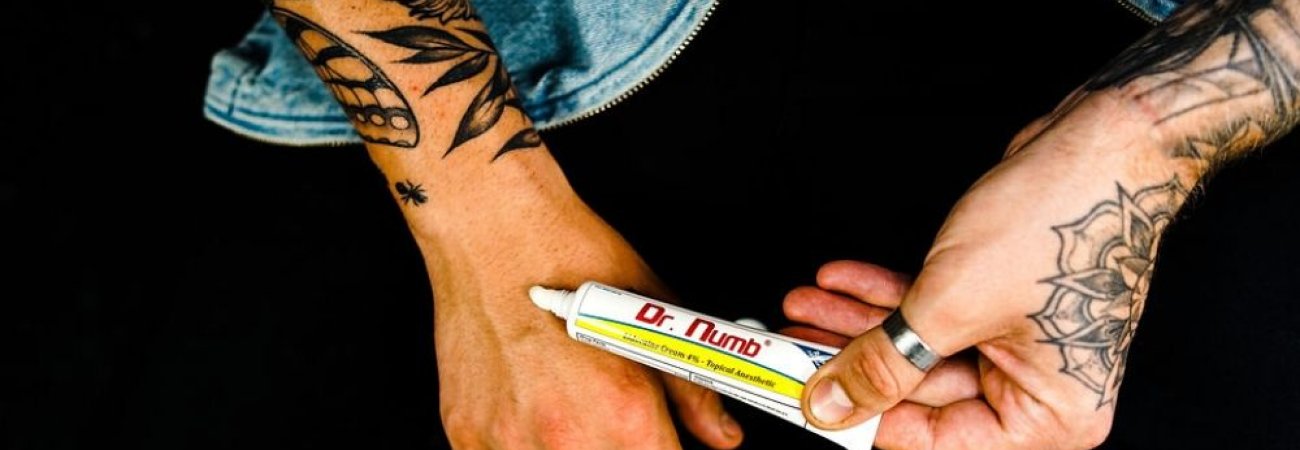There is a possibility of pain, edema, and prolonged bleeding after piercing. Sometimes, bumps can occur from an infection characterized by discomfort, swelling, redness, or warmth. In such cases, the bump will diminish as healing progresses.
It is not necessary to treat piercing bumps because they are a natural response to injury. But you can take steps to keep the piercing clean and prevent infection so that it can heal. These include keeping your piercing jewelry in for at least six weeks without changing or removing it.
To alleviate discomfort from piercing bumps, consider using a numbing cream like Dr. Numb® before cleaning the area. Additionally, maintain good oral hygiene and use a saline solution to rinse your mouth to promote healing and prevent infection.
In this blog post, we'll delve into everything you need to know about tongue piercing bumps, including their causes, available treatments, and preventive measures to avoid them altogether.
How To Get Rid Of Tongue Piercing Bump: 8 Treatments

If you notice bumps around your tongue piercing, it's essential to identify the cause before determining the appropriate treatment. Here are some general treatment options that may help with various types of tongue piercing bumps:
- Saltwater Rinses
- A saltwater rinse can reduce inflammation and help promote healing. You can prepare a saltwater rinse by adding 1/4 teaspoon to 1/2 teaspoon of salt into a cup of warm water, swishing it around, and spitting it out after 30 seconds.
- Practice Good Oral Hygiene:
- Rinse your mouth with a non-alcoholic, saline solution after meals and before bedtime.
- Use a non-alcoholic, antimicrobial mouthwash to help prevent infection.
- Avoid Irritants:
- Refrain from playing with or moving the jewelry excessively, as this can irritate the piercing.
- Avoid spicy or hot foods, as well as tobacco and alcohol, which can irritate the piercing.

- Jewelry:
- Make sure that the jewelry is made of materials that are high-quality, such as surgical stainless steel, titanium, or gold.
- Consider switching to a longer barbell if the initial swelling hasn't completely subsided.
- Keep the piercing jewelry the same for at least six weeks.
- Avoid Over-Cleaning:
- Cleaning too frequently with harsh products can be counterproductive. Stick to the recommended aftercare routine provided by your piercer.
- Apply Cold Compress:
- If the bump is due to swelling or infection, apply ice to your mouth.
- Leave it Alone:
- Sometimes, the best approach is to leave the piercing alone and let your body heal naturally. Avoid excessive touching or movement of the jewelry.
- Consult a Professional:
- If the bump persists or worsens, consult your piercer or a healthcare professional. They can provide guidance and may recommend antibiotics or other treatments if an infection is present.
Tongue Piercing Bump: Causes

Understanding the underlying causes is crucial to determine the most effective treatment method. Here are the most common causes of a tongue piercing bump:
- Infection: An infection is one of the most common reasons for a piercing bump. A variety of factors can lead to infections, including poor hygiene, using unsterilized tools, or touching the pierced area with dirty hands.
- Allergic reactions: Another reason for a tongue piercing bump can be an allergic reaction. Allergic reactions can be due to the jewelry or aftercare products used. Hypersensitivity can cause your body to react adversely, even to mild irritants, resulting in a piercing bump.
- Irritation: Tongue piercings can be a source of irritation. A bump can develop due to friction caused by the piercing jewelry or the piercing itself. Changes in your diet or smoking can also irritate the piercing and cause a bump.
- Keloids: Keloids are another factor that can cause a bump on your tongue piercing. The formation of keloids is caused by the overgrowth of scar tissue, which can occur when there is too much collagen production.
Preventing Tongue Piercing Bumps

While tongue piercing bumps can be unsightly and uncomfortable, they are preventable. Here are some tips to avoid the formation of bumps after getting your tongue pierced:
- Ensure that you choose a professional piercer who uses sterile equipment and adheres to proper piercing techniques.
- Invest in high-quality jewelry made from surgical steel or titanium to minimize the risk of an allergic reaction. Make sure that your jewelry is the right size.
- Keeping your mouth clean with an antibacterial mouthwash and brushing your teeth will prevent the accumulation of bacteria and infections.
- Avoid playing with the piercing or removing the jewelry before the area has fully healed.

Conclusion
Tongue piercing bump can be a frustrating and painful experience, but with the right treatment and prevention methods, it can be easily managed or avoided altogether. The first step is to figure out the cause.
The key to getting rid of and preventing tongue piercing bumps is to be patient, diligent with aftercare and hygiene, and proactively seek professional care if needed. You can keep your piercing looking and feeling great for years with a little effort and care.










![The Recovery Time and Stages of Nipple Piercings [Best Practices]](http://drnumb.com/cdn/shop/articles/How_Long_Do_Nipple_Piercings_Take_To_Heal__3_Stages_Explained.jpg?v=1714373243)

